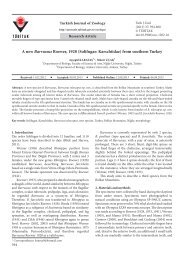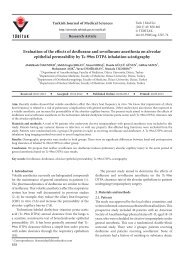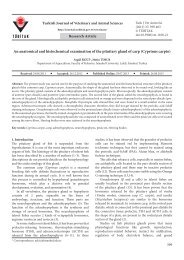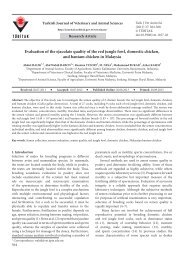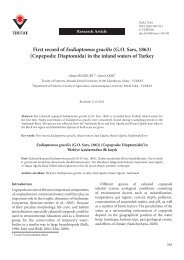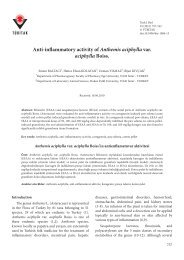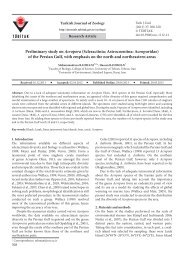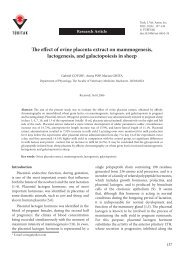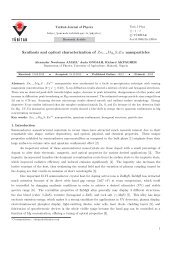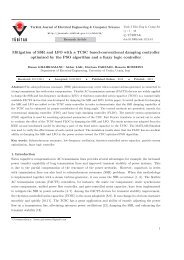Management of Tribolium castaneum (Herbst) based on hue response
Management of Tribolium castaneum (Herbst) based on hue response
Management of Tribolium castaneum (Herbst) based on hue response
Create successful ePaper yourself
Turn your PDF publications into a flip-book with our unique Google optimized e-Paper software.
Introducti<strong>on</strong><br />
<str<strong>on</strong>g>Tribolium</str<strong>on</strong>g> <str<strong>on</strong>g>castaneum</str<strong>on</strong>g> (<str<strong>on</strong>g>Herbst</str<strong>on</strong>g>), a species with a<br />
well developed chemosensory system (Barrer, 1983),<br />
is able to differentiate changes in the physical<br />
envir<strong>on</strong>ment such as temperature (Saxena et al., 1992;<br />
D<strong>on</strong>ahaye et al., 1996; Dowdy, 1999), humidity<br />
(Evans, 1983), carb<strong>on</strong> dioxide tensi<strong>on</strong> (Spratt, 1984;<br />
Soderstrom et al., 1992), and even different <strong>hue</strong>s<br />
immediately around it in the envir<strong>on</strong>ment. Previous<br />
studies reported the presence <str<strong>on</strong>g>of</str<strong>on</strong>g> colour preference or<br />
avoidance in T. <str<strong>on</strong>g>castaneum</str<strong>on</strong>g> grubs and adults (Ramos et<br />
Research Article<br />
<str<strong>on</strong>g>Management</str<strong>on</strong>g> <str<strong>on</strong>g>of</str<strong>on</strong>g> <str<strong>on</strong>g>Tribolium</str<strong>on</strong>g> <str<strong>on</strong>g>castaneum</str<strong>on</strong>g> (<str<strong>on</strong>g>Herbst</str<strong>on</strong>g>)<br />
<str<strong>on</strong>g>based</str<strong>on</strong>g> <strong>on</strong> <strong>hue</strong> resp<strong>on</strong>se<br />
Turk J Zool<br />
34 (2010) 367-375<br />
© TÜBİTAK<br />
doi:10.3906/zoo-0712-3<br />
Paul Raj Beautlin SHERIBHA, Alfred Premjith JINHAM, Sathiadas Sam Manohar DAS*,<br />
Kesary Reeba JASMINE<br />
Man<strong>on</strong>maniam Sundaranar University, Tirunelveli, Department <str<strong>on</strong>g>of</str<strong>on</strong>g> Postgraduate Studies and Research Centre in<br />
Zoology, Scott Christian College (Aut<strong>on</strong>omous), Nagercoil - 629 003, Tamil Nadu, INDIA<br />
Received: 05.12.2007<br />
Abstract: Possibilities for the management <str<strong>on</strong>g>of</str<strong>on</strong>g> <str<strong>on</strong>g>Tribolium</str<strong>on</strong>g> <str<strong>on</strong>g>castaneum</str<strong>on</strong>g> (<str<strong>on</strong>g>Herbst</str<strong>on</strong>g>) <strong>on</strong> stored products using coloured lighting<br />
systems was assessed in this study. Adult beetles were exposed in a choice chamber to red, blue, green, and clear tungsten<br />
light. T. <str<strong>on</strong>g>castaneum</str<strong>on</strong>g> adults preferred tungsten, blue, and green lights, and avoided red light. For each colour, beetles were<br />
separately reared for 3 generati<strong>on</strong>s. Beetles preferred the colour in which they were reared, except for red, which was<br />
avoided even by the beetles reared in a red-coloured envir<strong>on</strong>ment for 3 generati<strong>on</strong>s under duress. These beetles moved<br />
towards clear tungsten light in a choice chamber. It is evident that red light is not preferred by T. <str<strong>on</strong>g>castaneum</str<strong>on</strong>g> adults; they<br />
always moved away from envir<strong>on</strong>ments exposed to red light. Thus, if storage areas are lit red, T. <str<strong>on</strong>g>castaneum</str<strong>on</strong>g> beetles could<br />
be managed without the use <str<strong>on</strong>g>of</str<strong>on</strong>g> chemical pesticides. An SDS-PAGE <str<strong>on</strong>g>of</str<strong>on</strong>g> whole body proteins showed varying patterns in<br />
T. <str<strong>on</strong>g>castaneum</str<strong>on</strong>g> sixth instar grubs reared in differently coloured envir<strong>on</strong>ments.<br />
Key words: T. <str<strong>on</strong>g>castaneum</str<strong>on</strong>g>, colour preference, SDS-PAGE, red light<br />
* E-mail: sambioc<strong>on</strong>trol@gmail.com<br />
al., 1983; Viswanathan et al., 1996; Khan et al., 1998).<br />
Coloured lighting could be used to generate different<br />
<strong>hue</strong>s in the envir<strong>on</strong>ment that altered the behavioural<br />
resp<strong>on</strong>se <str<strong>on</strong>g>of</str<strong>on</strong>g> T. <str<strong>on</strong>g>castaneum</str<strong>on</strong>g>. The objective <str<strong>on</strong>g>of</str<strong>on</strong>g> this study<br />
was to understand the resp<strong>on</strong>se <str<strong>on</strong>g>of</str<strong>on</strong>g> T. <str<strong>on</strong>g>castaneum</str<strong>on</strong>g> grubs<br />
and adults to different coloured envir<strong>on</strong>ments. This<br />
study was intended to check the earlier claim that T.<br />
<str<strong>on</strong>g>castaneum</str<strong>on</strong>g> preferred certain colours and avoided<br />
certain others. The exact colours attractive and<br />
repulsive to T. <str<strong>on</strong>g>castaneum</str<strong>on</strong>g> were determined. Attracti<strong>on</strong><br />
to light <str<strong>on</strong>g>of</str<strong>on</strong>g> a particular <strong>hue</strong> is an established neur<strong>on</strong>al<br />
367
<str<strong>on</strong>g>Management</str<strong>on</strong>g> <str<strong>on</strong>g>of</str<strong>on</strong>g> <str<strong>on</strong>g>Tribolium</str<strong>on</strong>g> <str<strong>on</strong>g>castaneum</str<strong>on</strong>g> (<str<strong>on</strong>g>Herbst</str<strong>on</strong>g>) <str<strong>on</strong>g>based</str<strong>on</strong>g> <strong>on</strong> <strong>hue</strong> resp<strong>on</strong>se<br />
resp<strong>on</strong>se <str<strong>on</strong>g>of</str<strong>on</strong>g> T. <str<strong>on</strong>g>castaneum</str<strong>on</strong>g>. This study examined<br />
whether this neural mechanism could be entrained<br />
after a few generati<strong>on</strong>s, indicating a clear-cut genetic<br />
basis for their behaviour.<br />
Light is a form <str<strong>on</strong>g>of</str<strong>on</strong>g> electromagnetic radiati<strong>on</strong>, which<br />
may induce a stress reacti<strong>on</strong> in organisms exposed to<br />
it. Any stress reacti<strong>on</strong> is biochemically expressed in<br />
the form <str<strong>on</strong>g>of</str<strong>on</strong>g> stress proteins in the blood or<br />
haemolymph. T. <str<strong>on</strong>g>castaneum</str<strong>on</strong>g>, when exposed to<br />
different <strong>hue</strong>s, was expected to experience a stress<br />
reacti<strong>on</strong> that could be quantified by studying the<br />
protein pr<str<strong>on</strong>g>of</str<strong>on</strong>g>ile <str<strong>on</strong>g>of</str<strong>on</strong>g> the haemolymph or whole body<br />
proteins.<br />
Materials and methods<br />
The colour preference <str<strong>on</strong>g>of</str<strong>on</strong>g> T. <str<strong>on</strong>g>castaneum</str<strong>on</strong>g> adults and<br />
grubs was analysed using a multicolour cylindrical<br />
testing system, 11.5 L in volume, with a central release<br />
area <str<strong>on</strong>g>of</str<strong>on</strong>g> about 300 cm 2 , painted white. The cylindrical<br />
chamber was provided with 5 cylindrical arms, each<br />
about 40 cm l<strong>on</strong>g, painted white interiorly. At the end<br />
<str<strong>on</strong>g>of</str<strong>on</strong>g> the tunnel formed by each <str<strong>on</strong>g>of</str<strong>on</strong>g> the arms, 40 W<br />
electric bulbs were fixed. The first arm was provided<br />
with a red bulb; the sec<strong>on</strong>d, blue; the third, green; the<br />
fourth, clear tungsten; and the fifth was without any<br />
lighting. Approximately 10 g <str<strong>on</strong>g>of</str<strong>on</strong>g> wheat flour was placed<br />
in shallow glass petri dishes at the end <str<strong>on</strong>g>of</str<strong>on</strong>g> each <str<strong>on</strong>g>of</str<strong>on</strong>g> the<br />
5 cylindrical tunnels. Care was taken not to spill food<br />
in the release area or in the arms <str<strong>on</strong>g>of</str<strong>on</strong>g> the cylinders. The<br />
system was covered with an opaque lid that prevented<br />
outside light from entering the system.<br />
About 150 adults (starved for 7 days) or sixth<br />
instar grubs (starved 12 h) <str<strong>on</strong>g>of</str<strong>on</strong>g> T. <str<strong>on</strong>g>castaneum</str<strong>on</strong>g> in a<br />
shallow vial (2 cm deep) were placed in the beetle<br />
release area and the system was covered with the lid.<br />
The beetles were starved so that they would quickly<br />
move towards food <strong>on</strong>ce they were released. Satiated<br />
beetles took more time for movement. About 10 min<br />
were allowed before simultaneously switching <strong>on</strong> the<br />
lights in the system.<br />
Entrainment<br />
The T. <str<strong>on</strong>g>castaneum</str<strong>on</strong>g> adults were retrieved from the<br />
choice chamber <strong>on</strong> the eighth day <str<strong>on</strong>g>of</str<strong>on</strong>g> observati<strong>on</strong> and<br />
transferred to large wooden dark boxes, lit exclusively<br />
368<br />
with a particular colour. Beetles that preferred a<br />
particular colour in the choice chamber were<br />
transferred to opaque boxes exclusively lit with that<br />
colour. For instance, beetles collected at the end <str<strong>on</strong>g>of</str<strong>on</strong>g> the<br />
red-lit arm were transferred to a red-lit box. Feeding<br />
was d<strong>on</strong>e without any external lighting. Food was<br />
placed in shallow trays about 2 cm deep. The trays<br />
were placed inside the boxes. During feeding, the<br />
boxes were opened and flour was added to the trays.<br />
On no account were the beetles exposed to any other<br />
colour <str<strong>on</strong>g>of</str<strong>on</strong>g> light than the colour to which they were<br />
being entrained. After 3 generati<strong>on</strong>s were completed<br />
(roughly 3 m<strong>on</strong>ths), <str<strong>on</strong>g>based</str<strong>on</strong>g> <strong>on</strong> c<strong>on</strong>trol comparis<strong>on</strong>, the<br />
adult beetles were tested for their colour preference in<br />
the multicolour cylindrical testing system. Six<br />
replicates were run. The boxes were placed in a dark<br />
room and the beetles inside a box were c<strong>on</strong>stantly<br />
exposed to a particular colour for about 3 m<strong>on</strong>ths,<br />
during which time 3 generati<strong>on</strong>s were completed. The<br />
c<strong>on</strong>trol beetles were maintained inside a box lit with<br />
tungsten light.<br />
Grubs<br />
The impact <str<strong>on</strong>g>of</str<strong>on</strong>g> coloured light <strong>on</strong> T. <str<strong>on</strong>g>castaneum</str<strong>on</strong>g><br />
grubs was also studied. Sixth instar grubs were<br />
exposed to red, green, blue, and tungsten light for a<br />
period <str<strong>on</strong>g>of</str<strong>on</strong>g> 12 and 24 h (short-term exposure). During<br />
exposure, the insects were placed <strong>on</strong> open dishes<br />
without any flour cover. After exposure, the grubs<br />
were c<strong>on</strong>cealed in flour covered by paper sheets <str<strong>on</strong>g>of</str<strong>on</strong>g><br />
appropriate colours to match the light <strong>hue</strong> to which<br />
they were exposed. Red-exposed beetles were covered<br />
by red sheets, green-exposed by green sheets, blueexposed<br />
by blue sheets, and tungsten-exposed by dull<br />
white sheets.<br />
The grubs were brought to the laboratory and<br />
subsequently used for electrophoretic studies. The<br />
c<strong>on</strong>trol beetles and grubs were exposed to clear light<br />
from a tungsten lamp. Grubs were used for<br />
electrophoretic studies because <str<strong>on</strong>g>of</str<strong>on</strong>g> their high<br />
sensitivity compared with adult beetles. When 100<br />
grubs were released, the mean number <str<strong>on</strong>g>of</str<strong>on</strong>g> unattracted<br />
grubs was 5.21 ± 0.76, whereas, in the case <str<strong>on</strong>g>of</str<strong>on</strong>g> T.<br />
<str<strong>on</strong>g>castaneum</str<strong>on</strong>g> adults, the mean was 42.85 ± 8.5,<br />
indicating a much higher resp<strong>on</strong>se to light in T.<br />
<str<strong>on</strong>g>castaneum</str<strong>on</strong>g> grubs (Tables 1 and 2).
Sample preparati<strong>on</strong><br />
The treated grubs were pooled in lots <str<strong>on</strong>g>of</str<strong>on</strong>g> 10 mg and<br />
washed with double distilled water and then insect ringer<br />
soluti<strong>on</strong> to remove the debris. Larvae were crushed in<br />
500 mL <str<strong>on</strong>g>of</str<strong>on</strong>g> homogenising buffer (Tris-EDTA, pH 6.8).<br />
Homogenisati<strong>on</strong> was d<strong>on</strong>e in an ice-bath under freezing<br />
c<strong>on</strong>diti<strong>on</strong>s. Every sample was homogenised separately.<br />
Homogenised samples were centrifuged at 12,000 rpm<br />
for 10 min at 4 °C in a refrigerated centrifuge.<br />
Supernatant was taken out, mixed with an equal volume<br />
<str<strong>on</strong>g>of</str<strong>on</strong>g> sample buffer, and stored at 4 °C.<br />
The protein pr<str<strong>on</strong>g>of</str<strong>on</strong>g>iles <str<strong>on</strong>g>of</str<strong>on</strong>g> whole body tissues <str<strong>on</strong>g>of</str<strong>on</strong>g> the<br />
treated grubs were analysed using sodium dodecyl<br />
sulphate polyacrylamide gel electrophoresis (SDS-<br />
PAGE), a low-cost, reproducible, and rapid method<br />
Table 1. Light attractancy <str<strong>on</strong>g>of</str<strong>on</strong>g> T. <str<strong>on</strong>g>castaneum</str<strong>on</strong>g> sixth instar grubs (n = 5).<br />
P. R. B. SHERIBHA, A. P. JINHAM, S. S. M. DAS, K. R. JASMINE<br />
Released C<strong>on</strong>trol Blue Green Red Unlit Unattracted<br />
100 19.5 ± 1.6 25.8 ± 1.9 39.5 ± 3.2 6.16 ± 0.59 4.84 ± 2.4 5.21 ± 0.76<br />
(32.24) (102.4) (-68.30) (-75.05) (-73.16)<br />
200 40.5 ± 3.8 49.5 ± 3.1 87.2 ± 5.3 10.3 ± 0.72 6.1 ± 0.52 8.2 ± 0.64<br />
(22.14) (114.88) (-74.29) (-84.62) (-79.45)<br />
Note: Percent change over c<strong>on</strong>trol.<br />
Values in parentheses are deviati<strong>on</strong>s significant at P ≤ 0.05 (Student’s t-test).<br />
Table 2. Light attractancy <str<strong>on</strong>g>of</str<strong>on</strong>g> T. <str<strong>on</strong>g>castaneum</str<strong>on</strong>g> adults (n = 6).<br />
Number <str<strong>on</strong>g>of</str<strong>on</strong>g> beetles<br />
Tungsten lamp<br />
Released Unlit Unattracted<br />
Clear Blue Green Red<br />
100 26.6 ± 4.2 7.71 ± 1.24 8.29 ± 1.6 3.71 ± 0.94 10.86 ± 2.4 42.85 ± 8.5<br />
(-71.0) (-68.82) (-68.8) (-59.1) (61.0)<br />
200 58.7 ± 8.4 16.22 ± 3.8 18.95 ± 4.2 7.96 ± 1.22 17.96 ± 3.02 80.4 ± 12.8<br />
(-72.3) (-67.6) (-86.4) (-69.3) (36.9)<br />
400 128.7 ± 16.2 28.96 ± 3.9 41.3 ± 6.8 18.34 ± 3.1 39.86 ± 4.6 143.11 ± 18.2<br />
(-76.7) (-67.2) (-84.9) (-68.4) (11.09)<br />
500 159.9 ± 19.6 38.82 ± 5.1 49.76 ± 6.1 23.9 ± 4.6 54.42 ± 7.36 173.4 ± 21.2<br />
(-75.6) (-68.8) (-85.0) (-65.92) (8.43)*<br />
Note: Percent change over c<strong>on</strong>trol.<br />
Value in parentheses with asterisk is not significant at P ≤ 0.05 (Student’s t-test).<br />
for quantifying, comparing, and characterising<br />
proteins <str<strong>on</strong>g>based</str<strong>on</strong>g> <strong>on</strong> separati<strong>on</strong> by their molecular<br />
weight. The use <str<strong>on</strong>g>of</str<strong>on</strong>g> i<strong>on</strong>ic detergents like SDS was<br />
intended to eliminate the 2-dimensi<strong>on</strong>al structure <str<strong>on</strong>g>of</str<strong>on</strong>g><br />
the polypeptides and to provide net negative charges<br />
to each polypeptide, so that all <str<strong>on</strong>g>of</str<strong>on</strong>g> them moved<br />
towards the anode (positive pole) when the voltage<br />
gradient was applied to the gel. Due to these features,<br />
the mobility <str<strong>on</strong>g>of</str<strong>on</strong>g> the proteins in SDS-PAGE was directly<br />
proporti<strong>on</strong>al to their molecular size (polypeptide<br />
length). Protein c<strong>on</strong>centrati<strong>on</strong> <str<strong>on</strong>g>of</str<strong>on</strong>g> whole tissue was<br />
determined following the method <str<strong>on</strong>g>of</str<strong>on</strong>g> Lowry et al.,<br />
(1951). Bovine serum albumin served as the standard<br />
protein. Protein determinati<strong>on</strong> was d<strong>on</strong>e to<br />
standardise the amount <str<strong>on</strong>g>of</str<strong>on</strong>g> tissue to be used for the<br />
preparati<strong>on</strong> <str<strong>on</strong>g>of</str<strong>on</strong>g> samples for electrophoretic studies.<br />
369
<str<strong>on</strong>g>Management</str<strong>on</strong>g> <str<strong>on</strong>g>of</str<strong>on</strong>g> <str<strong>on</strong>g>Tribolium</str<strong>on</strong>g> <str<strong>on</strong>g>castaneum</str<strong>on</strong>g> (<str<strong>on</strong>g>Herbst</str<strong>on</strong>g>) <str<strong>on</strong>g>based</str<strong>on</strong>g> <strong>on</strong> <strong>hue</strong> resp<strong>on</strong>se<br />
Results<br />
The first generati<strong>on</strong> T. <str<strong>on</strong>g>castaneum</str<strong>on</strong>g> adults preferred<br />
clear tungsten light. When 100 beetles were exposed<br />
to 4 different colours <str<strong>on</strong>g>of</str<strong>on</strong>g> light, the highest number<br />
(26.6 ± 4.2) was attracted to the clear tungsten lamp.<br />
Up<strong>on</strong> the release <str<strong>on</strong>g>of</str<strong>on</strong>g> 500 beetles, the same trend was<br />
noticed: the highest number <str<strong>on</strong>g>of</str<strong>on</strong>g> beetles preferred clear<br />
tungsten light (159.9 ± 19.6). In blue-, green-, and<br />
red-coloured lighting, the number <str<strong>on</strong>g>of</str<strong>on</strong>g> attracted beetles<br />
was lower. Nearly 30% <str<strong>on</strong>g>of</str<strong>on</strong>g> the released T. <str<strong>on</strong>g>castaneum</str<strong>on</strong>g><br />
adults did not show any attracti<strong>on</strong> to different sources<br />
<str<strong>on</strong>g>of</str<strong>on</strong>g> light (Table 2).<br />
When the T. <str<strong>on</strong>g>castaneum</str<strong>on</strong>g> specimens that resp<strong>on</strong>ded<br />
to blue light were reared separately, the third<br />
generati<strong>on</strong> adults showed more attracti<strong>on</strong> to the blue<br />
light [42.1 ± 6.5 (n = 100) and 200.8 ± 25.6 (n = 500)],<br />
and 25% <str<strong>on</strong>g>of</str<strong>on</strong>g> the third generati<strong>on</strong> adults were not at all<br />
attracted (n = 100) to any type <str<strong>on</strong>g>of</str<strong>on</strong>g> light (Table 3). A<br />
similar trend was noted in third generati<strong>on</strong> adults<br />
exposed to green light (Table 4).<br />
In c<strong>on</strong>trast, when the third generati<strong>on</strong> red<br />
attractants were exposed to different light sources,<br />
they preferred the clear tungsten lamp [38.4 ± 5.6 (n<br />
= 100) and 201.84 ± 28.6 (n = 500)], followed by green<br />
(12.6 ± 2.8 and 61.8 ± 10.2) and blue (10.8 ± 3.9 and<br />
51.32 ± 10.4) lights. They did not show any attracti<strong>on</strong><br />
to red light (1.8 ± 0.94 and 8.2 ± 2.5) (Table 5).<br />
370<br />
The third generati<strong>on</strong> adults <str<strong>on</strong>g>of</str<strong>on</strong>g> T. <str<strong>on</strong>g>castaneum</str<strong>on</strong>g> that<br />
were attracted to the clear tungsten lamp showed a<br />
pr<str<strong>on</strong>g>of</str<strong>on</strong>g>ound attracti<strong>on</strong> to clear tungsten light (38.2 ± 5.7<br />
and 201.62 ± 29.8), followed by green (6.14 ± 3.2 and<br />
34.38 ± 6.2), blue (4.32 ± 1.6 and 24.36 ± 35.8), and<br />
red (1.8 ± 0.5 and 11.2 ± 3.4) lights. Similar to the first<br />
generati<strong>on</strong> adults, nearly 25% <str<strong>on</strong>g>of</str<strong>on</strong>g> the total third<br />
generati<strong>on</strong> adults did not have any type <str<strong>on</strong>g>of</str<strong>on</strong>g> attracti<strong>on</strong><br />
to light (Table 6).<br />
Electropherograms showing the total body protein<br />
pr<str<strong>on</strong>g>of</str<strong>on</strong>g>ile <str<strong>on</strong>g>of</str<strong>on</strong>g> T. <str<strong>on</strong>g>castaneum</str<strong>on</strong>g> sixth instar grubs exposed to<br />
different wavelengths <str<strong>on</strong>g>of</str<strong>on</strong>g> the visible spectrum for a<br />
period <str<strong>on</strong>g>of</str<strong>on</strong>g> 12h and 24h are presented in Figures 1 and 2.<br />
The total body protein pr<str<strong>on</strong>g>of</str<strong>on</strong>g>ile <str<strong>on</strong>g>of</str<strong>on</strong>g> T. <str<strong>on</strong>g>castaneum</str<strong>on</strong>g><br />
grubs was modified under different lighting<br />
c<strong>on</strong>diti<strong>on</strong>s. In 12 h exposure, certain modificati<strong>on</strong>s <str<strong>on</strong>g>of</str<strong>on</strong>g><br />
the protein pattern could be observed (Figure 1). In<br />
c<strong>on</strong>trol grubs, there were about 14 bands. The<br />
molecular weight <str<strong>on</strong>g>of</str<strong>on</strong>g> this protein was around 43 kDa,<br />
but in the case <str<strong>on</strong>g>of</str<strong>on</strong>g> grubs exposed to red light the<br />
number <str<strong>on</strong>g>of</str<strong>on</strong>g> bands decreased to 9. One protein band<br />
was visible in the molecular weight area <str<strong>on</strong>g>of</str<strong>on</strong>g> 43 kDa,<br />
<strong>on</strong>e protein band in 29 kDa, and <strong>on</strong>e in 14.3 kDa.<br />
Three protein bands were visible in between the<br />
molecular weight areas <str<strong>on</strong>g>of</str<strong>on</strong>g> 14.3 and 29 kDa. The<br />
electrophoretic experiments were replicated 3 times<br />
and c<strong>on</strong>sistent results were obtained.<br />
Table 3. Light attractancy <str<strong>on</strong>g>of</str<strong>on</strong>g> T. <str<strong>on</strong>g>castaneum</str<strong>on</strong>g> adults after 3 generati<strong>on</strong>s in blue light (n = 5).<br />
Number <str<strong>on</strong>g>of</str<strong>on</strong>g> beetles<br />
Tungsten lamp<br />
Released Unlit Unattracted<br />
Clear Blue Green Red<br />
100 8.6 ± 1.2 42.1 ± 6.5 6.8 ± 1.01 2.4 ± 0.6 15.6 ± 3.2 24.52 ± 7.8<br />
(389.27) (-20.91) (-72.04) (81.34) (1184.99)<br />
200 18.32 ± 3.1 78.3 ± 14.6 15.3 ± 2.8 5.3 ± 1.2 32.8 ± 6.5 49.92 ± 8.2<br />
(326.89) (-16.45) (-70.95) (78.91) (172.22)<br />
400 39.46 ± 5.2 170.2 ± 21.4 24.8 ± 4.6 9.96 ± 1.9 71.8 ± 10.4 83.82 ± 10.2<br />
(330.77) (-37.08) (-74.6) (81.82) (44.36)<br />
500 48.94 ± 7.6 200.8 ± 25.6 34.86 ± 6.5 13.1 ± 2.1 91.2 ± 14.8 111.18 ± 16.2<br />
(310.24) (-28.76) (-73.22) (86.33) (127.15)<br />
Note: Percent change over c<strong>on</strong>trol.<br />
Value in parentheses with asterisk is not significant at P ≤ 0.05 (Student’s t-test).
In the specimens exposed to green light, there<br />
were about 12 bands. The molecular weight <str<strong>on</strong>g>of</str<strong>on</strong>g> the<br />
protein was around 14.3 kDa. One protein band was<br />
visible in the molecular weight area <str<strong>on</strong>g>of</str<strong>on</strong>g> 205 kDa.<br />
In the case <str<strong>on</strong>g>of</str<strong>on</strong>g> grubs exposed to blue light, 11 bands<br />
were detected. The molecular weight <str<strong>on</strong>g>of</str<strong>on</strong>g> the protein<br />
was around 14.3 kDa. The fourth band occurred in<br />
the 43 kDa regi<strong>on</strong>.<br />
P. R. B. SHERIBHA, A. P. JINHAM, S. S. M. DAS, K. R. JASMINE<br />
Table 4. Light attractancy <str<strong>on</strong>g>of</str<strong>on</strong>g> T. <str<strong>on</strong>g>castaneum</str<strong>on</strong>g> adults after 3 generati<strong>on</strong>s in green light (n = 5).<br />
Number <str<strong>on</strong>g>of</str<strong>on</strong>g> beetles<br />
Tungsten lamp<br />
Released Unlit Unattracted<br />
Clear Blue Green Red<br />
100 14.8 ± 2.8 5.6 ± 1.02 32.8 ± 5.6 1.48 ± 0.24 28.48 ± 4.1 16.86 ± 2.9<br />
(-62.15) (121.60) (-89.98) (92.42) (13.91)<br />
200 30.6 ± 5.8 12.48 ± 2.4 70.28 ± 10.6 3.62 ± 0.96 61.42 ± 11.6 21.65 ± 4.8<br />
(-59.19) (129.63) (-88.14) (100.68) (-29.23)<br />
400 54.21 ± 9.6 21.68 ± 4.2 128.38 ± 17,8 6.96 ± 1.11 138.22 ± 18.2 50.52 ± 8.92<br />
(-59.98) (136.76) (-87.12) (154.91) (-6.80)<br />
500 71.32 ± 10.5 31.48 ± 6.8 171.32 ± 21.2 9.12 ± 2.4 171.38 ± 24.6 45.42 ± 8.2<br />
(-55.85) (140.2) (-87.20) (140.28) (-36.31)*<br />
Note: Percent change over c<strong>on</strong>trol.<br />
Value in parentheses with asterisk is not significant at P ≤ 0.05 (Student’s t-test).<br />
Table 5. Light attractancy <str<strong>on</strong>g>of</str<strong>on</strong>g> T. <str<strong>on</strong>g>castaneum</str<strong>on</strong>g> adults after 3 generati<strong>on</strong>s in red light (n = 3).<br />
Number <str<strong>on</strong>g>of</str<strong>on</strong>g> beetles<br />
Tungsten lamp<br />
Released Unlit Unattracted<br />
Clear Blue Green Red<br />
100 38.4 ± 5.6 10.8 ± 3.9 12.6 ± 2.8 1.8 ± 0.94 14.68 ± 3.2 21.68 ± 4.8<br />
(-71.8) (-67.1) (-95.3) (-61.7) (-43.5)<br />
200 79.36 ± 10.8 24.32 ± 6.8 20.8 ± 5.2 30.86 ± 7.5 40.58 ± 7.2<br />
(-69.3) (-73.78) (-94.8) (-61.1) (-48.86)<br />
400 152.84 ± 21.4 36.48 ± 7.8 43.96 ± 9.6 5.8 ± 1.9 54.82 ± 10.6 106.14 ± 11.3<br />
(-76.09) (-71.20) (-96.16) (-64.10) (-30.53)<br />
500 201.84 ± 28.6 51.32 ± 10.4 61.8 ± 10.2 8.2 ± 2.5 71.8 ± 9.2 105.09 ± 12.8<br />
(-74.50) (-69.31) (-95.85) (-64.36) (-47.89)<br />
Note: Percent change over c<strong>on</strong>trol.<br />
Value in parentheses with asterisk is not significant at P ≤ 0.05 (Student’s t-test).<br />
With exposure to clear tungsten light, there were<br />
14 bands. The fourteenth band showed the maximum<br />
volume <str<strong>on</strong>g>of</str<strong>on</strong>g> protein, and the molecular weight <str<strong>on</strong>g>of</str<strong>on</strong>g> this<br />
protein was around 14.3 kDa. The fifth band occurred<br />
in the 43 kDa regi<strong>on</strong>.<br />
As previously observed, the total body protein<br />
pr<str<strong>on</strong>g>of</str<strong>on</strong>g>ile <str<strong>on</strong>g>of</str<strong>on</strong>g> T. <str<strong>on</strong>g>castaneum</str<strong>on</strong>g> grubs was modified under<br />
different lighting c<strong>on</strong>diti<strong>on</strong>s. In 24 h exposure, certain<br />
371
<str<strong>on</strong>g>Management</str<strong>on</strong>g> <str<strong>on</strong>g>of</str<strong>on</strong>g> <str<strong>on</strong>g>Tribolium</str<strong>on</strong>g> <str<strong>on</strong>g>castaneum</str<strong>on</strong>g> (<str<strong>on</strong>g>Herbst</str<strong>on</strong>g>) <str<strong>on</strong>g>based</str<strong>on</strong>g> <strong>on</strong> <strong>hue</strong> resp<strong>on</strong>se<br />
205<br />
97.4<br />
66<br />
43<br />
29<br />
20.1<br />
14.3<br />
modificati<strong>on</strong>s <str<strong>on</strong>g>of</str<strong>on</strong>g> the protein pattern could also be<br />
observed (Figure 2). In c<strong>on</strong>trol grubs, there were<br />
about 14 bands. The molecular weight <str<strong>on</strong>g>of</str<strong>on</strong>g> this protein<br />
372<br />
Table 6. Light attractancy <str<strong>on</strong>g>of</str<strong>on</strong>g> T. <str<strong>on</strong>g>castaneum</str<strong>on</strong>g> adults after 3 generati<strong>on</strong>s in clear tungsten lamp-lit c<strong>on</strong>diti<strong>on</strong>s<br />
(n = 5).<br />
Number <str<strong>on</strong>g>of</str<strong>on</strong>g> beetles<br />
Tungsten lamp<br />
Released Unlit Unattracted<br />
Clear Blue Green Red<br />
100 38.2 ± 5.7 4.32 ± 1.6 6.14 ± 3.2 1.8 ± 0.5 11.52 ± 3.4 28.18 ± 9.2<br />
(-88.42) (-83.67) (-97.90) (-69.63) (-0.052)<br />
200 81.2 ± 10.5 9.46 ± 2.2 14.32 ± 2.6 3.1 ± 0.96 24.64 ± 4.6 67.32 ± 10.8<br />
(-80.24) (-82.26) (-96.06) (-69.56) (-17.07)<br />
400 152.44 ± 21.8 17.96 ± 3.2 26.72 ± 4.8 7.4 ± 1.5 41.86 ± 8.2 153.6 ± 23.4<br />
(-88.08) (-82.34) (-95.0) (-72.42) (.759) *<br />
500 201.62 ± 29.8 24.36 ± 35.8 34.38 ± 6.2 11.2 ± 3.4 58.38 ± 11.6 170.4 ± 32.8<br />
(-87.74) (-82.78) (-94.25) (-70.90) (-15.45)<br />
Note: Percent change over c<strong>on</strong>trol.<br />
Value in parentheses with asterisk is not significant at P ≤ 0.05 (Student’s t-test).<br />
1 2 3 4 5 6<br />
Figure 1. Total body protein pr<str<strong>on</strong>g>of</str<strong>on</strong>g>ile for T. <str<strong>on</strong>g>castaneum</str<strong>on</strong>g> sixth instar<br />
larvae (12 h exposure to visible spectrum).<br />
Lane 1 - Molecular weight marker<br />
Lane 2 - Tungsten light exposure<br />
Lane 3 - Blue light exposure<br />
Lane 4 - Green light exposure<br />
Lane 5 - Red light exposure<br />
Lane 6 - C<strong>on</strong>trol<br />
205<br />
97.4<br />
66<br />
43<br />
29<br />
20.1<br />
14.3<br />
1 2 3 4 5 6<br />
Figure 2. Total body protein pr<str<strong>on</strong>g>of</str<strong>on</strong>g>ile for T. <str<strong>on</strong>g>castaneum</str<strong>on</strong>g> sixth instar<br />
larvae (24 h exposure to visible spectrum).<br />
Lane 1 - Molecular weight marker<br />
Lane 2 - Tungsten light exposure<br />
Lane 3 - Blue light exposure<br />
Lane 4 - Green light exposure<br />
Lane 5 - Red light exposure<br />
Lane 6 - C<strong>on</strong>trol<br />
was around 43 kDa. The thirteenth band occurred in<br />
the 20.1 kDa regi<strong>on</strong>.
In exposure to red light, there were <strong>on</strong>ly 9 bands.<br />
The seventh band showed the maximum volume <str<strong>on</strong>g>of</str<strong>on</strong>g><br />
protein, and the molecular weight <str<strong>on</strong>g>of</str<strong>on</strong>g> this protein was<br />
around 43 kDa.<br />
In exposure to green light, there were about 9<br />
bands. The molecular weight <str<strong>on</strong>g>of</str<strong>on</strong>g> the fifth protein was<br />
around 66 kDa.<br />
In the case <str<strong>on</strong>g>of</str<strong>on</strong>g> grubs exposed to blue light for 24 h,<br />
the number <str<strong>on</strong>g>of</str<strong>on</strong>g> bands was 11. The molecular weight <str<strong>on</strong>g>of</str<strong>on</strong>g><br />
this protein was around 43 kDa.<br />
In exposure to clear tungsten light, there were<br />
about 13 bands. The molecular weight <str<strong>on</strong>g>of</str<strong>on</strong>g> this protein<br />
was around 14.3 kDa; the tenth and eleventh bands<br />
occurred in the 29 and 20.1 kDa regi<strong>on</strong>s (Table 7).<br />
Discussi<strong>on</strong><br />
Stored grain pests normally live inside bags<br />
c<strong>on</strong>taining stored produce in an unlit envir<strong>on</strong>ment.<br />
When these insects move about during cross<br />
infestati<strong>on</strong>, the envir<strong>on</strong>ment open to them is a dimly<br />
lit warehouse. The objective <str<strong>on</strong>g>of</str<strong>on</strong>g> this study was to<br />
identify whether T. <str<strong>on</strong>g>castaneum</str<strong>on</strong>g> adults had any<br />
preference for comm<strong>on</strong> incandescent light colours<br />
and to find out which colour they least preferred, with<br />
an aim <str<strong>on</strong>g>of</str<strong>on</strong>g> using this colour to light warehouses <str<strong>on</strong>g>of</str<strong>on</strong>g><br />
stored produce and thus deter beetles from moving<br />
within the space. Ramos et al. (1983) investigated the<br />
possibility <str<strong>on</strong>g>of</str<strong>on</strong>g> using laser light for c<strong>on</strong>trolling pests in<br />
preserved foods. Lasers produced both a thermal<br />
P. R. B. SHERIBHA, A. P. JINHAM, S. S. M. DAS, K. R. JASMINE<br />
Table 7. Protein distributi<strong>on</strong> for sixth instar T. <str<strong>on</strong>g>castaneum</str<strong>on</strong>g> grubs exposed to coloured lighting.<br />
Lighting type<br />
Molecular weight (in kDa)<br />
205 97.4 66 43 29 20.1 14.3<br />
Tungsten b a,b a,b a,b b a,b a<br />
Blue - b b a,b b a a,b<br />
Green a - b a,b - a,b a,b<br />
Red - b b a,b a b a,b<br />
C<strong>on</strong>trol + + + + + + +<br />
a - 12 h exposure to visible spectrum<br />
b - 24 h exposure to visible spectrum<br />
‘- ’ indicates absence <str<strong>on</strong>g>of</str<strong>on</strong>g> protein <str<strong>on</strong>g>of</str<strong>on</strong>g> a particular molecular weight<br />
‘+’ indicates presence <str<strong>on</strong>g>of</str<strong>on</strong>g> protein <str<strong>on</strong>g>of</str<strong>on</strong>g> a particular molecular weight<br />
effect and electromagnetic energy. Exposure to lasers<br />
induced anorexia, shortened life span, reduced<br />
mobility, dehydrati<strong>on</strong>, increased melanisati<strong>on</strong>,<br />
sclerotisati<strong>on</strong>, partial sterilisati<strong>on</strong>, developmental<br />
failure, and reducti<strong>on</strong> in the size <str<strong>on</strong>g>of</str<strong>on</strong>g> the F1 populati<strong>on</strong><br />
in T. <str<strong>on</strong>g>castaneum</str<strong>on</strong>g>. The heat generated by tungsten<br />
lamps was much less than the heat produced by laser<br />
beams. The electromagnetic radiati<strong>on</strong> associated with<br />
the light was in the visible range <str<strong>on</strong>g>of</str<strong>on</strong>g> the<br />
electromagnetic spectrum. But unlike laser beams, the<br />
tungsten lamp attracted beetles and the light was<br />
dispersed over a wider area. Laser generators are<br />
costly, whereas the comm<strong>on</strong> incandescent light is very<br />
cheap. The cost involved in generating and<br />
maintaining laser beams was also prohibitively higher.<br />
The 4 different populati<strong>on</strong>s <str<strong>on</strong>g>of</str<strong>on</strong>g> beetles released<br />
inside the multicolour light system showed uniform<br />
behaviour with reference to their light preference. The<br />
largest number <str<strong>on</strong>g>of</str<strong>on</strong>g> beetles was attracted to the chamber<br />
lit with clear tungsten lamps. Another significant<br />
finding was that a large number <str<strong>on</strong>g>of</str<strong>on</strong>g> beetles were not<br />
attracted to any light source. It is comm<strong>on</strong> for a<br />
nocturnal insect to avoid all light sources. The beetles<br />
released into the multicolour light system were<br />
starved for 7 days prior to the experiment to ensure<br />
movement towards any <strong>on</strong>e <str<strong>on</strong>g>of</str<strong>on</strong>g> the coloured chambers<br />
provisi<strong>on</strong>ed with food. The beetles seemed to prefer<br />
darkness to light because their natural envir<strong>on</strong>ment<br />
remained unlit. The beetles did not dem<strong>on</strong>strate an<br />
aversi<strong>on</strong> to clear light. The photoreceptors <str<strong>on</strong>g>of</str<strong>on</strong>g> the<br />
beetle are capable <str<strong>on</strong>g>of</str<strong>on</strong>g> differentiating clear light and<br />
373
<str<strong>on</strong>g>Management</str<strong>on</strong>g> <str<strong>on</strong>g>of</str<strong>on</strong>g> <str<strong>on</strong>g>Tribolium</str<strong>on</strong>g> <str<strong>on</strong>g>castaneum</str<strong>on</strong>g> (<str<strong>on</strong>g>Herbst</str<strong>on</strong>g>) <str<strong>on</strong>g>based</str<strong>on</strong>g> <strong>on</strong> <strong>hue</strong> resp<strong>on</strong>se<br />
darkness (Khan et al., 1998). Blue and green lights<br />
attracted more beetles than red-coloured light. Ashfaq<br />
et al. (2005) showed that for most insects, red light is<br />
not attractive. This str<strong>on</strong>gly supports the result <str<strong>on</strong>g>of</str<strong>on</strong>g> this<br />
study, in which beetles were least attracted to red<br />
light. Even though the exact mechanism behind the<br />
photostimulati<strong>on</strong> and locomotory resp<strong>on</strong>se <str<strong>on</strong>g>of</str<strong>on</strong>g> T.<br />
<str<strong>on</strong>g>castaneum</str<strong>on</strong>g> was not clearly known, the beetles showed<br />
the least preference for red-coloured light. When 100<br />
beetles were released, <strong>on</strong>ly 3.71 ± 0.94 were found in<br />
the chamber illuminated with red light. When 500<br />
beetles were released, 23.9 ± 4.6 beetles were found in<br />
the chamber lit with red light. Thus, the significant<br />
impact <str<strong>on</strong>g>of</str<strong>on</strong>g> light <strong>hue</strong> <strong>on</strong> T. <str<strong>on</strong>g>castaneum</str<strong>on</strong>g> beetles is clearly<br />
indicated. The significant impact <str<strong>on</strong>g>of</str<strong>on</strong>g> the number <str<strong>on</strong>g>of</str<strong>on</strong>g><br />
beetles attracted to differently coloured light was also<br />
clearly indicated. Viswanathan et al. (1996) showed<br />
that T. <str<strong>on</strong>g>castaneum</str<strong>on</strong>g> adults showed a clear positive<br />
resp<strong>on</strong>se to bright light and the colour orange. Mixed<br />
resp<strong>on</strong>ses were obtained for black, blue, green, red,<br />
and pink, and T. <str<strong>on</strong>g>castaneum</str<strong>on</strong>g> resp<strong>on</strong>ded to yellow <strong>on</strong>ly<br />
at an extremely low intensity.<br />
The c<strong>on</strong>diti<strong>on</strong>ing <str<strong>on</strong>g>of</str<strong>on</strong>g> beetles to light <str<strong>on</strong>g>of</str<strong>on</strong>g> any particular<br />
colour was studied. The beetles were primarily attracted<br />
to blue in the initial experiments when reared in bluelit<br />
c<strong>on</strong>diti<strong>on</strong>s for 3 generati<strong>on</strong>s. About 200.8 ± 25.6<br />
beetles in a populati<strong>on</strong> <str<strong>on</strong>g>of</str<strong>on</strong>g> 500 were attracted to blue<br />
light. This indicated entrainment <strong>on</strong> the part <str<strong>on</strong>g>of</str<strong>on</strong>g> the<br />
beetle to a particular colour. These beetles were less<br />
attracted to unlit c<strong>on</strong>diti<strong>on</strong>s or clear light.<br />
A similar trend was observed in the light-attracted<br />
movements <str<strong>on</strong>g>of</str<strong>on</strong>g> adults reared for 3 generati<strong>on</strong>s in green<br />
light. The number <str<strong>on</strong>g>of</str<strong>on</strong>g> beetles attracted to green light<br />
was comparatively higher than the number <str<strong>on</strong>g>of</str<strong>on</strong>g> beetles<br />
in chambers with other colours <str<strong>on</strong>g>of</str<strong>on</strong>g> light. Beetles<br />
c<strong>on</strong>diti<strong>on</strong>ed to green light had an inclinati<strong>on</strong> to move<br />
into the unlit chamber, as well.<br />
Slightly different results were observed in the lightdirected<br />
movements <str<strong>on</strong>g>of</str<strong>on</strong>g> T. <str<strong>on</strong>g>castaneum</str<strong>on</strong>g> adults raised for 3<br />
generati<strong>on</strong>s in red-coloured light. These beetles<br />
preferred to avoid red light. Only 8.2 ± 2.5 beetles were<br />
located in the red-lit chamber when 500 beetles were<br />
released. There was a clear resp<strong>on</strong>se towards avoidance<br />
<str<strong>on</strong>g>of</str<strong>on</strong>g> red light. The beetles showed normal reproducti<strong>on</strong><br />
for 3 generati<strong>on</strong>s when they were placed in a large<br />
chamber with red lighting and not allowed to escape<br />
from this chamber. From the colour preference<br />
374<br />
experiment, it could be presumed that the beetles raised<br />
for 3 generati<strong>on</strong>s inside a chamber lit with red light<br />
would have fled the chamber if there had been an exit.<br />
T. <str<strong>on</strong>g>castaneum</str<strong>on</strong>g> adults were forced into the chamber<br />
illuminated with red light. Based <strong>on</strong> earlier<br />
observati<strong>on</strong>s, the beetles avoided red light, and they<br />
would have repeated the same behaviour if possible.<br />
When T. <str<strong>on</strong>g>castaneum</str<strong>on</strong>g> adults were reared for 3<br />
generati<strong>on</strong>s in clear tungsten light, the beetles were<br />
attracted more to clear light than to lights <str<strong>on</strong>g>of</str<strong>on</strong>g> other<br />
colours. A large populati<strong>on</strong> remained unattracted to<br />
light in the central chamber. When 400 beetles were<br />
released, 152.44 ± 21.8 entered the chamber with clear<br />
light, while 153.6 ± 23.4 remained unattracted. The<br />
exact reas<strong>on</strong> for such a reacti<strong>on</strong> was not clearly<br />
known. Khan et al. (1998) reported about the<br />
influence <str<strong>on</strong>g>of</str<strong>on</strong>g> coloured light <strong>on</strong> orientati<strong>on</strong>,<br />
locomoti<strong>on</strong>, feeding, mating, ovipositi<strong>on</strong>, adult<br />
emergence, and the development <str<strong>on</strong>g>of</str<strong>on</strong>g> insects. The<br />
authors showed that the weight <str<strong>on</strong>g>of</str<strong>on</strong>g> grubs raised in<br />
colourless light was 4.22 mg, compared to weights in<br />
black light (3.8 mg), orange (3.7 mg), blue (3.9 mg),<br />
yellow (3.6 mg), green (3.8 mg), and red (3.6 mg). The<br />
average larval period was 12.25 days in colourless<br />
light, while it was 11.31 for blue, 11.26 for yellow,<br />
10.72 for green, and 11.5 for red. Developmental<br />
success was maximal in colourless light (98%) and<br />
minimal in red light (84%). The colour blue was<br />
reported to be intermediate, being statistically at par<br />
with the c<strong>on</strong>trol, as shown by the authors. The<br />
percentage emergence was minimal in red light, with<br />
a reducti<strong>on</strong> in the average larval period. These<br />
findings seemed to explain why the beetles preferred<br />
to avoid red light. The exact mechanism <str<strong>on</strong>g>of</str<strong>on</strong>g> reacti<strong>on</strong><br />
to coloured light was not known, but it was presumed<br />
that coloured light produced a negative effect <strong>on</strong> the<br />
metabolism <str<strong>on</strong>g>of</str<strong>on</strong>g> grubs or beetles. Such metabolic<br />
changes have been reported by Narayan et al. (1959),<br />
Vaidya et al. (1974), and Khan et al. (1998). The use <str<strong>on</strong>g>of</str<strong>on</strong>g><br />
light traps incorporating coloured lights is also a<br />
possible mechanism in reducing the populati<strong>on</strong> <str<strong>on</strong>g>of</str<strong>on</strong>g> T.<br />
<str<strong>on</strong>g>castaneum</str<strong>on</strong>g> in any infested warehouse.<br />
In the c<strong>on</strong>trol, proteins <str<strong>on</strong>g>of</str<strong>on</strong>g> 7 different molecular<br />
weights were observed. In exposure to red light, 4<br />
proteins were observed after 12 h <str<strong>on</strong>g>of</str<strong>on</strong>g> exposure, and five<br />
after 24 h. The 43 kDa protein was found in all T.<br />
<str<strong>on</strong>g>castaneum</str<strong>on</strong>g> grubs exposed to 4 different <strong>hue</strong>s <str<strong>on</strong>g>of</str<strong>on</strong>g> light.
References<br />
Ashfaq, M., Khan, A.R., Khan, M.A., Rasheed, F. and Shahid, H. 2005.<br />
Insect orientati<strong>on</strong> to various colour lights in the agricultural<br />
biomes <str<strong>on</strong>g>of</str<strong>on</strong>g> Faisalabad. Pak. Entomol. 27: 49-52.<br />
Barrer, T.M. 1983. A field dem<strong>on</strong>strati<strong>on</strong> <str<strong>on</strong>g>of</str<strong>on</strong>g> odour-<str<strong>on</strong>g>based</str<strong>on</strong>g>, host-food<br />
finding behaviour in several species <str<strong>on</strong>g>of</str<strong>on</strong>g> stored grain insects. J.<br />
Stored Prod. Res. 19: 105-111.<br />
D<strong>on</strong>ahaye, E.J., Navarro, S., Rindner, M. and Azrieli, A. 1996. The<br />
combined influence <str<strong>on</strong>g>of</str<strong>on</strong>g> temperature and modified atmospheres<br />
<strong>on</strong> <str<strong>on</strong>g>Tribolium</str<strong>on</strong>g> <str<strong>on</strong>g>castaneum</str<strong>on</strong>g> (<str<strong>on</strong>g>Herbst</str<strong>on</strong>g>) (Coleoptera: Tenebri<strong>on</strong>idae).<br />
J. Stored Prod. Res. 32: 225-232.<br />
Dowdy, A.K. 1999. Mortality <str<strong>on</strong>g>of</str<strong>on</strong>g> red flour beetle, <str<strong>on</strong>g>Tribolium</str<strong>on</strong>g> <str<strong>on</strong>g>castaneum</str<strong>on</strong>g><br />
(<str<strong>on</strong>g>Herbst</str<strong>on</strong>g>) (Coleoptera: Tenebri<strong>on</strong>idae) exposed to high<br />
temperature and diatomaceous earth combinati<strong>on</strong>s. J. Stored<br />
Prod. Res. 35: 175-182.<br />
Evans, D.E. 1983. The influence <str<strong>on</strong>g>of</str<strong>on</strong>g> relative humidity and thermal<br />
acclimati<strong>on</strong> <strong>on</strong> the survival <str<strong>on</strong>g>of</str<strong>on</strong>g> adult grain beetles in cooled<br />
grain. J. Stored Prod. Res. 19: 173-180.<br />
Khan, A.A., Rath, S. and Shankar, U. 1998. Effect <str<strong>on</strong>g>of</str<strong>on</strong>g> coloured light <strong>on</strong><br />
larval growth <str<strong>on</strong>g>of</str<strong>on</strong>g> rust red flour beetle, <str<strong>on</strong>g>Tribolium</str<strong>on</strong>g> <str<strong>on</strong>g>castaneum</str<strong>on</strong>g><br />
(<str<strong>on</strong>g>Herbst</str<strong>on</strong>g>). Shashpa 5: 181-184.<br />
Lowry, O.H., Rosebrough, N.J., Farr, A.L. and Randall, R.J. 1951.<br />
Protein measurement with the folin phenol reagent. J. Biol.<br />
Chem. 193: 265-275.<br />
Narayanan, E.S., Lal, R., Rahlkar G.W., Sethi, G.R. and Saxena, P.N.<br />
1959. Studies <strong>on</strong> the effects <str<strong>on</strong>g>of</str<strong>on</strong>g> beta radiati<strong>on</strong>s <strong>on</strong> insects. The<br />
effects <str<strong>on</strong>g>of</str<strong>on</strong>g> beta radiati<strong>on</strong> (irrigati<strong>on</strong> <str<strong>on</strong>g>of</str<strong>on</strong>g> egg stage and first instar<br />
larvae) <strong>on</strong> the life history <str<strong>on</strong>g>of</str<strong>on</strong>g> Corcyra cephal<strong>on</strong>ica Staint<strong>on</strong>. Proc.<br />
Ind. Acad. Sci. (Sect. B) 50: 82-87.<br />
P. R. B. SHERIBHA, A. P. JINHAM, S. S. M. DAS, K. R. JASMINE<br />
Ramos, E., De C<strong>on</strong>c<strong>on</strong>i, J., C<strong>on</strong>c<strong>on</strong>i, J., Elorduy, C., Oxley, T. and<br />
Barry, S. 1983. Laser light as a new potential method for pest<br />
c<strong>on</strong>trol in preserved foods. Biodeteriorati<strong>on</strong>. Proceedings <str<strong>on</strong>g>of</str<strong>on</strong>g> the<br />
5th Internati<strong>on</strong>al Biodeteriorati<strong>on</strong> Symposium, Aberdeen, UK.<br />
September 1981. Oxley, T.A. and Barry, S., eds. pp. 592-608.<br />
Saxena, B.P., Sharma, P.R., Thappa, P.K. and Tikku, K. 1992.<br />
Temperature induced sterilizati<strong>on</strong> for c<strong>on</strong>trol <str<strong>on</strong>g>of</str<strong>on</strong>g> three stored<br />
grain beetles. J. Stored Prod. Res. 28: 67-70.<br />
Soderstrom, E.L., Br<strong>on</strong>dl, D.G. and Mackey, B. 1992. High<br />
temperature combined with carb<strong>on</strong> oxide enriched or reduced<br />
oxygen atmospheres for c<strong>on</strong>trol <str<strong>on</strong>g>of</str<strong>on</strong>g> T. <str<strong>on</strong>g>castaneum</str<strong>on</strong>g> (<str<strong>on</strong>g>Herbst</str<strong>on</strong>g>)<br />
(Coleoptera: Tenebri<strong>on</strong>idae). J. Stored Prod. Res. 28: 235-238.<br />
Spratt, E.C. 1984. The effects <str<strong>on</strong>g>of</str<strong>on</strong>g> atmospheres c<strong>on</strong>taining 5-20%<br />
oxygen with and without 10% carb<strong>on</strong> dioxide <strong>on</strong> the<br />
productivity <str<strong>on</strong>g>of</str<strong>on</strong>g> <str<strong>on</strong>g>Tribolium</str<strong>on</strong>g> <str<strong>on</strong>g>castaneum</str<strong>on</strong>g> (<str<strong>on</strong>g>Herbst</str<strong>on</strong>g>) and T. c<strong>on</strong>fusum<br />
Duval (Coleoptera: Tenebri<strong>on</strong>idae). J. Stored Prod. Res. 20: 199-<br />
203.<br />
Vaidya, V.G., Kothari, R.M., Gedhole, N.N. and Patil, S.P. 1974. Effect<br />
<str<strong>on</strong>g>of</str<strong>on</strong>g> gamma irradiati<strong>on</strong> <strong>on</strong> the protein metabolism in<br />
Drosophilidae (Diptera). Radiat. Res. 57: 545-550.<br />
Viswanathan, G., Rao, S.J. and Chakravarthy, C. 1996. Resp<strong>on</strong>se <str<strong>on</strong>g>of</str<strong>on</strong>g><br />
<str<strong>on</strong>g>Tribolium</str<strong>on</strong>g> <str<strong>on</strong>g>castaneum</str<strong>on</strong>g> to different colours <str<strong>on</strong>g>of</str<strong>on</strong>g> light during night<br />
and change in their intensities. Insect Envir<strong>on</strong>ment 2: 94.<br />
375



